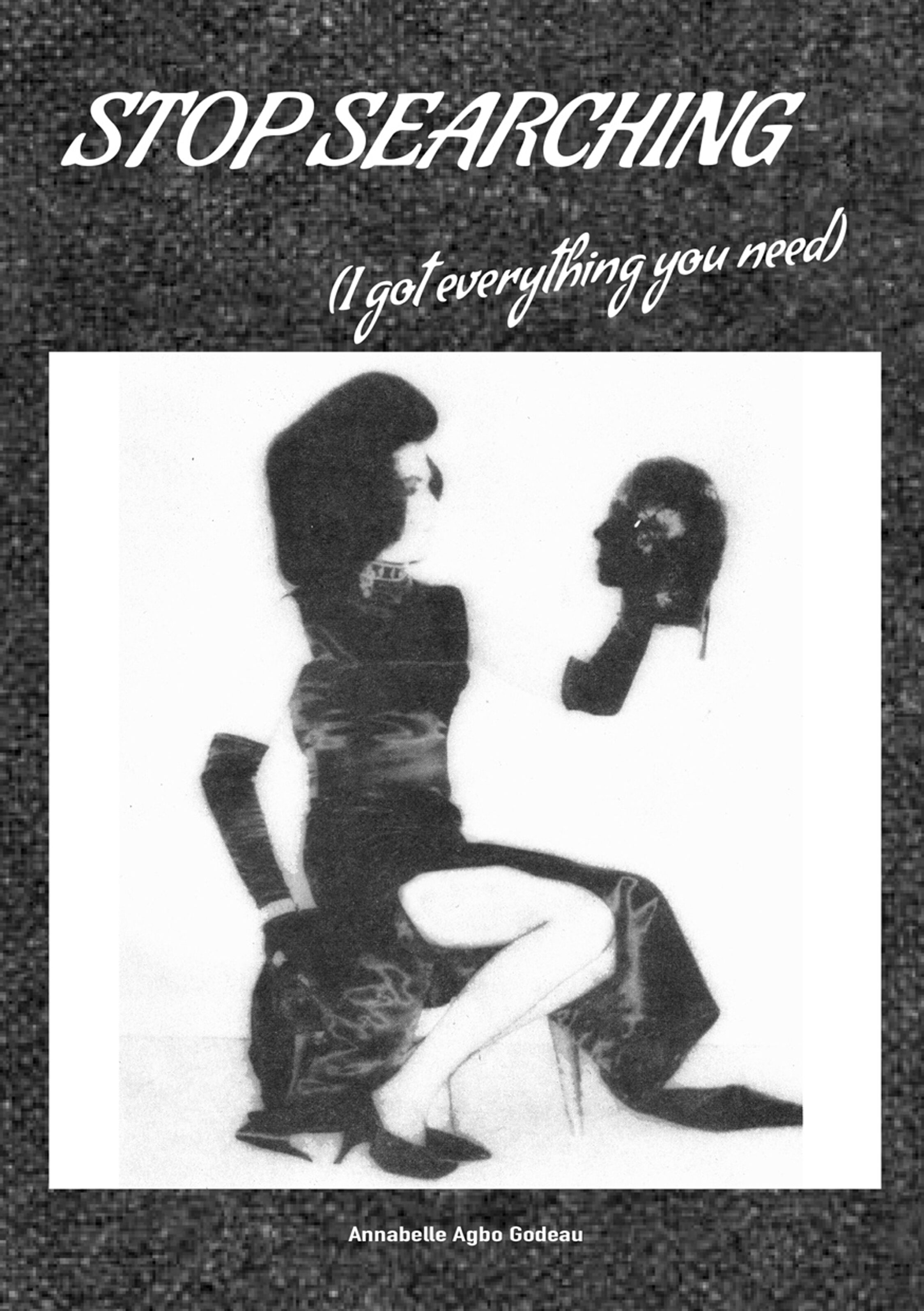
Frances Farmer got arrested. It happened in 1943, but you could still check her story.
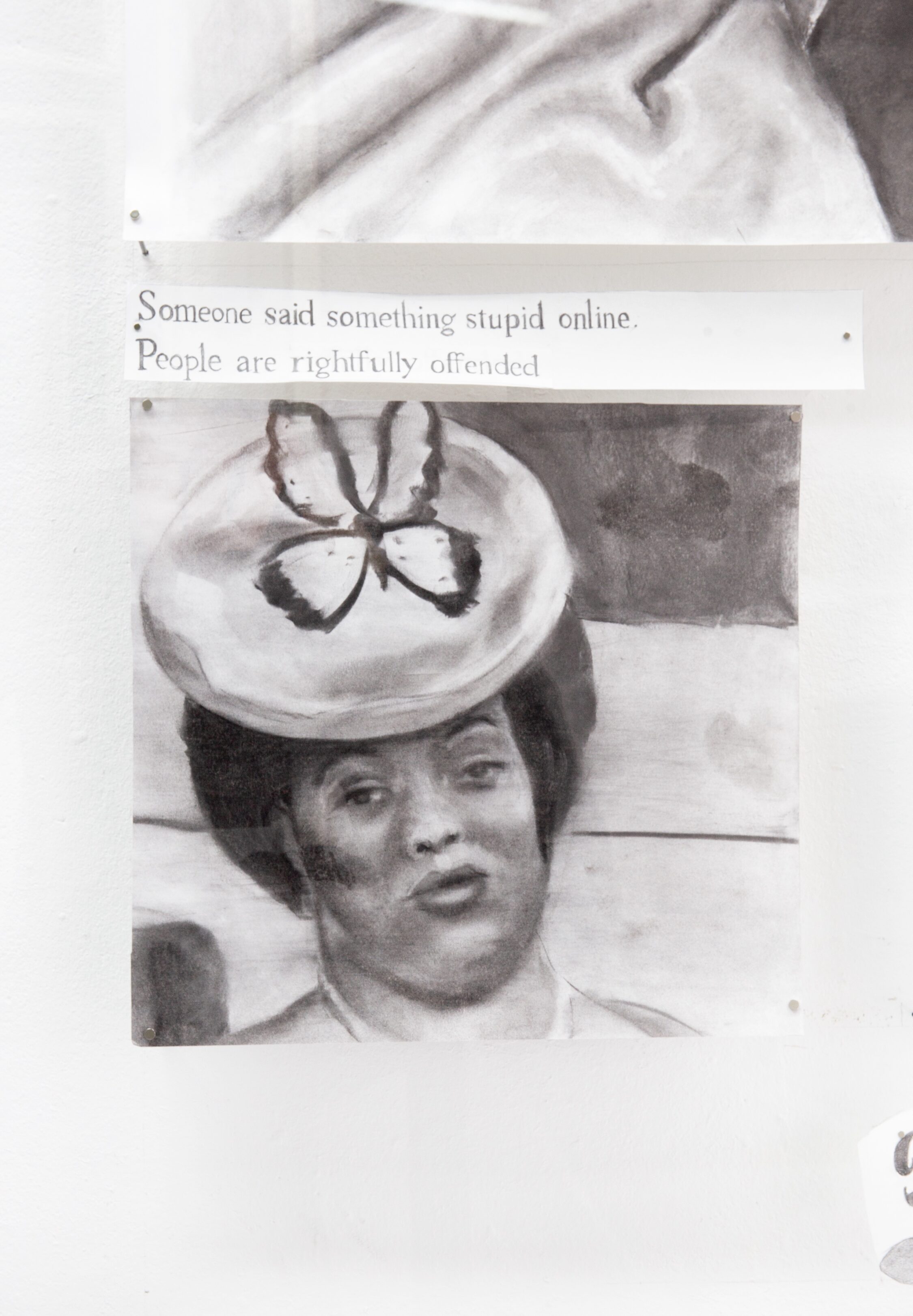
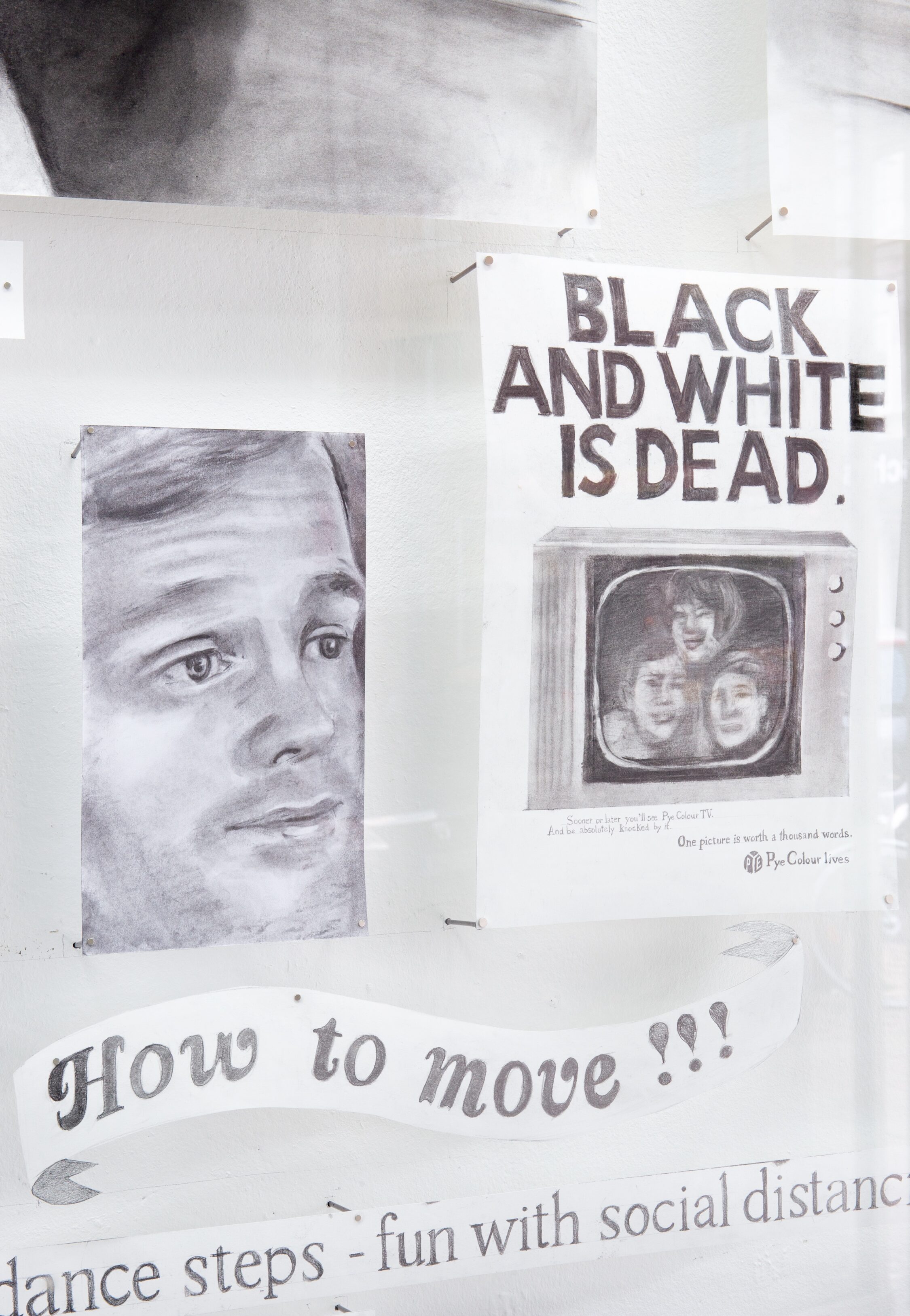
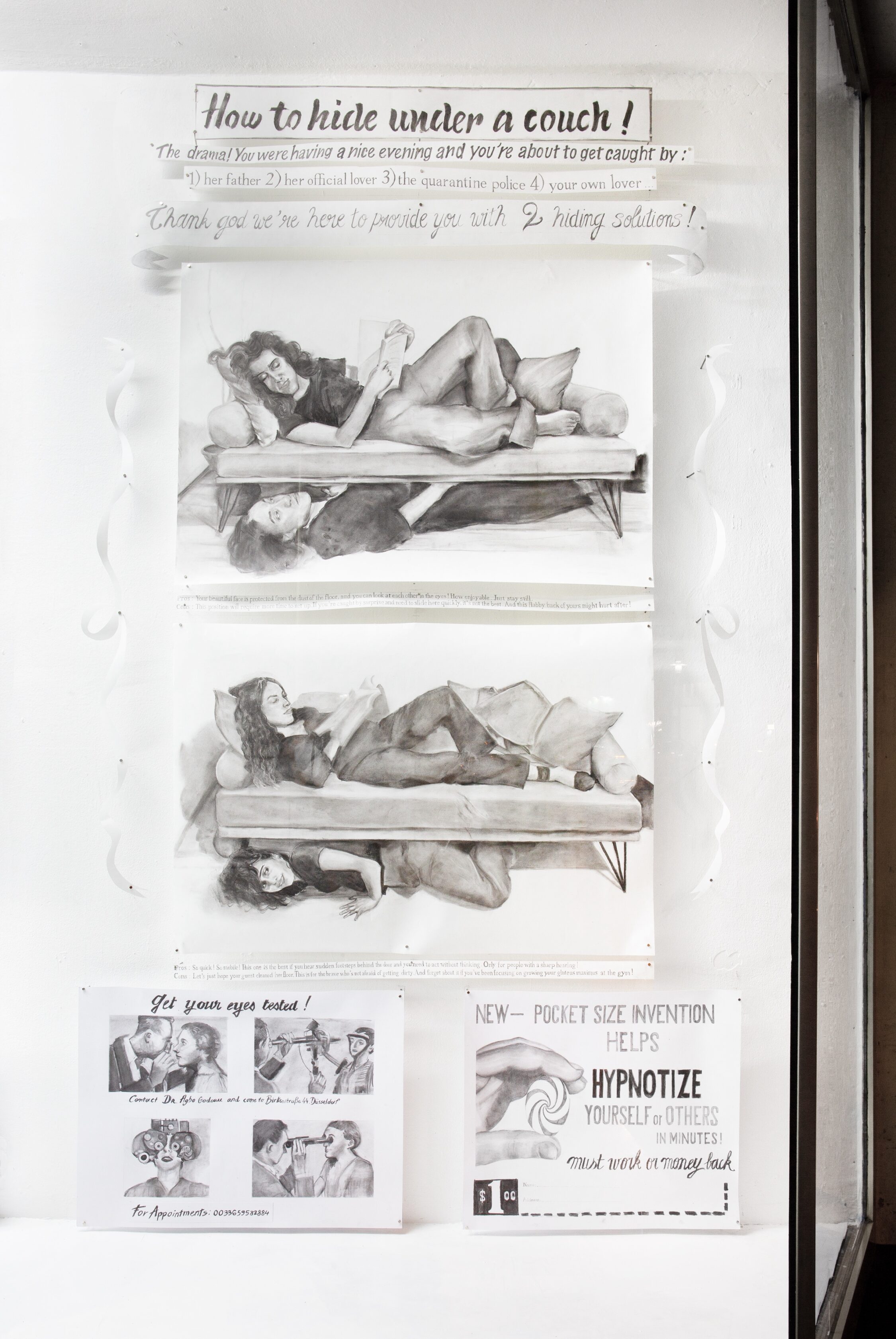
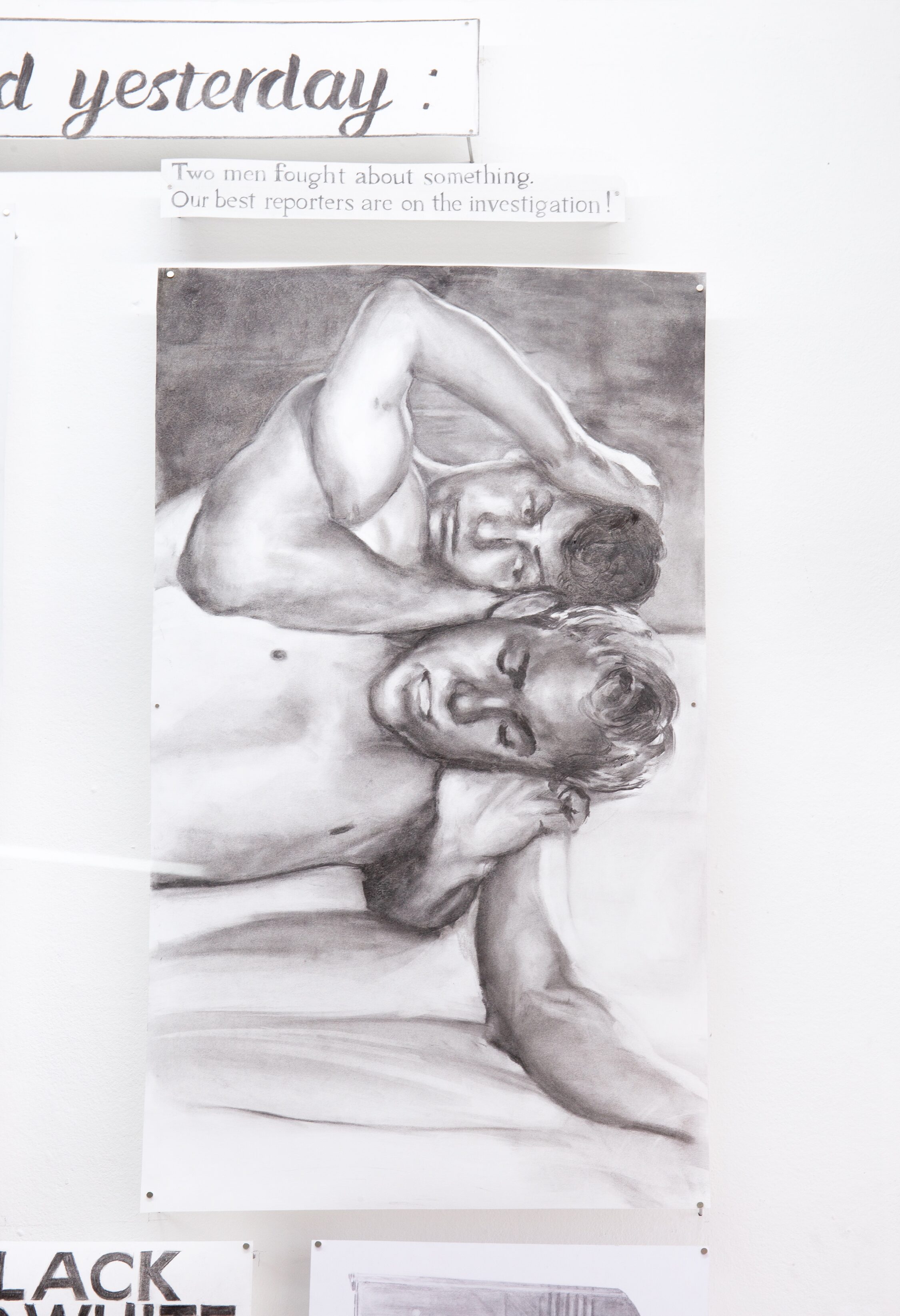
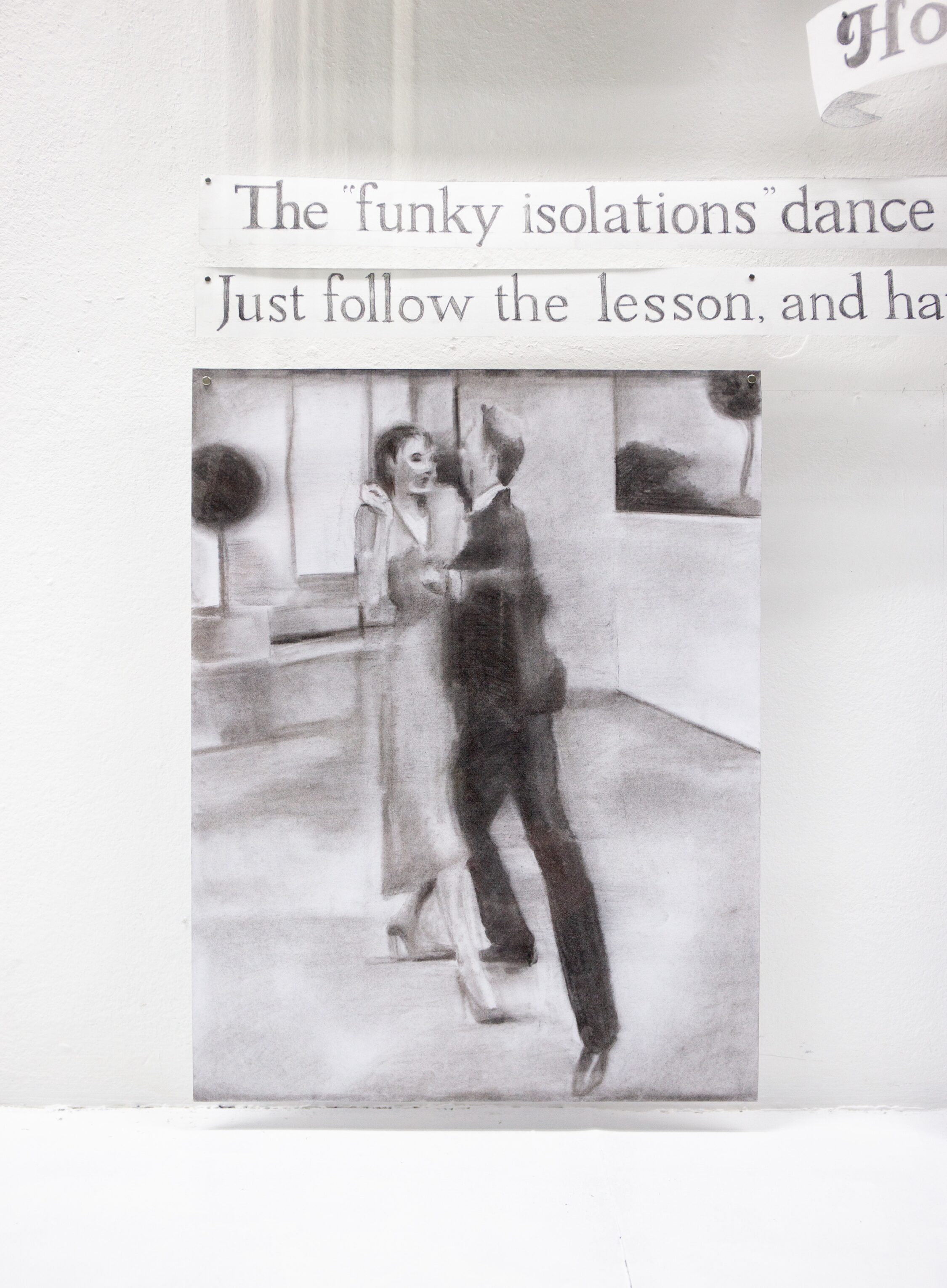


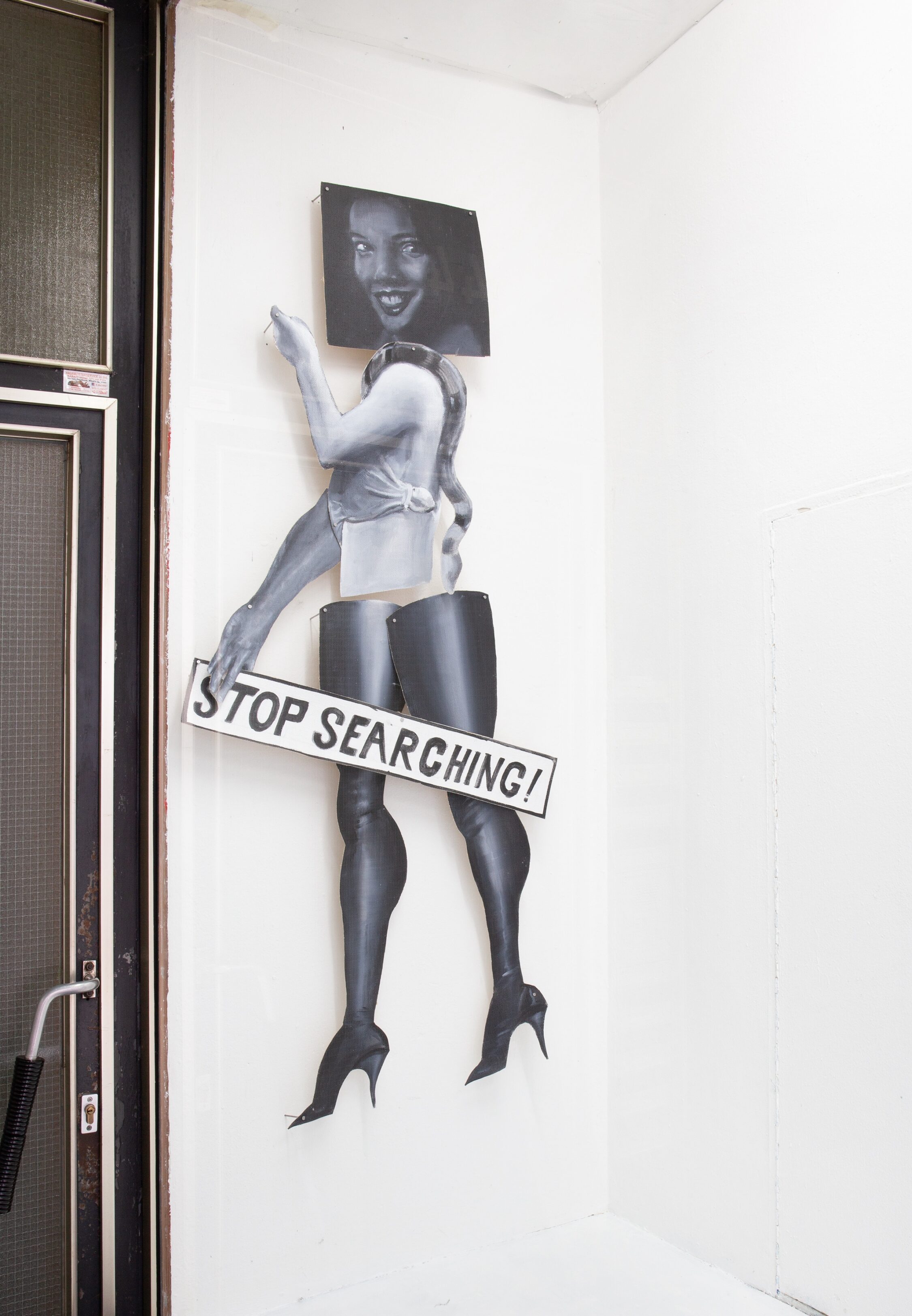


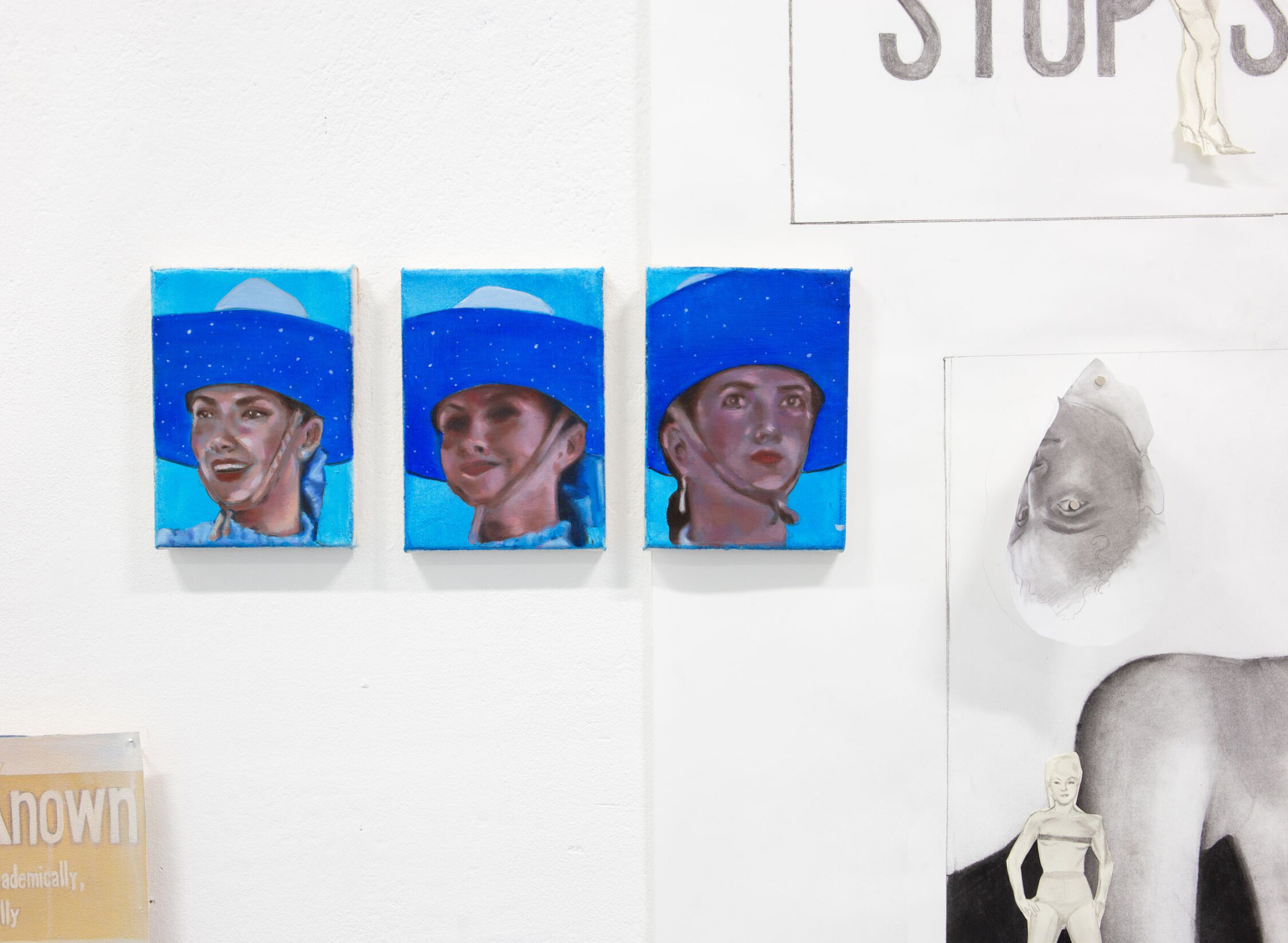



How to … (not) take a look at Annabelle Agbo Godeaus complex image-text- constellations
Romina Dümler
Nach einer gewissen Zeit beschäftigten mich die Blickbeziehungen zwischen den Personen in Annabelle Agbo Godeaus Bild-Text-Konstellationen am meisten.
Der intensive Augenkontakt des tanzenden Paares, während sich ihre Körper ungesehen aufeinander zubewegen und sich wieder entfernen und so ihre Choreografie der „funky isolations“ dance steps ausführen. Wie wir die Tänzer*innen beobachten müssen, um mitlernen zu können. Das Unvermögen einander anzusehen, wenn der Kopf auf dem eines anderen liegt, so wie im Bild der zwei miteinander rangelnden Männer. Der hypnotisierte, vermutlich nach innen gerichtete Blick, der medizinische Blick des Optikers, der seiner Kundin tief ins Auge schaut und der leere Blick ihrerseits, der zu ihm zurückgeht.
Nach längerem Hinsehen beschäftigte mich der Blick in den beiden Illustrationen zu how to hide under a couch. Diejenige, die auf dem Sofa liegt und die, die darunter schlüpft scheinen sich sowohl durch die An- als auch durch die Abwesenheit ihrer Blickbeziehung miteinander in Verbindung zu setzen. Zugleich wird die Sofa-Liege zu einer Symmetrieachse, an der die Körperhaltung beider umgekehrt aufeinander bezogen ist, gegeneinander gespiegelt.
Lacan hat die Fähigkeit sich im Spiegel erkenn zu können als grundlegende menschliche Entwicklung benannt, in dem dieser sich seiner selbst aber auch der Sichtweisen anderer bewusst wird. Erkennt sich die Eine in der Anderen oder geht es wirklich nur darum Dritte durch das Versteckspiel zu täuschen?
Für die Vitrine von sonneundsolche hat Annabelle Agbo Godeau eine Collage einer Frauenfigur sowie eine Zusammenstellung von Zeichnungen, die ein aufgeschlagenes Magazin nachempfindet, erarbeitet. Schon seit langem gilt Agbo Godeaus Interesse Vintage-Zeitschriften – oft sind das Erotikmagazine aus den 1940er und 50er Jahren. Neben Fotografien, die in ihrem Freundeskreis entstehen, entnimmt sie ihnen, ebenso wie Filmen, einen guten Teil der Bilder und Textfragmente, die sie in ihre Malereien überträgt und dort miteinander in Beziehung setzt. Meist wählt sie Frauen-Porträts, die diese bei ,sinnlich-glamourösen‘ Aktivitäten, bspw. bei (Eis-)Tanz oder Aerobic, einfangen oder die Künstlerin zieht Aufnahmen heran, in denen sie in stereotyp weiblichen Posen erscheinen. Während viele ihrer Malereien der letzten Jahre von einem kräftigen Blau durchzogen waren, das durch seine Referenz an sogenannte „Blue Movies“, also pornografische Filme, genauso wie an das fahle Licht unserer Computerscreens auf die Verknüpfung von Erotisierung und Begehren hinwies, zeigt Agbo Godeau in der Ausstellung Stop searching (I got everything you need)erstmals eine Zusammenstellung von Kohlezeichnungen.
Diese sind auch Konsequenz einer pandemiebedingten Einschränkung ihrer Produktionsverhältnisse. Viel mehr noch tragen diese aber die Entscheidung in sich, Zeitschriften nicht nur als Bildquellen heranzuziehen, sondern deren strukturelle Prinzipien und inhaltlichen Konventionen zu nutzen und mitauszustellen.
Dass die Künstlerin sich für das Fortleben der gesellschaftlichen Erwartungen und Vorstellungen, die in den Illustrierten gezeigt werden, interessiert ist gut spürbar am Tonfall in den Magazinseiten, den die Künstlerin lustvoll aus den Vorlagen adaptiert und mit zeitgenössischen Referenzen gespickt re-formuliert. In einem stets heiteren Ton werden die Zeichnungen von Über- und Unterschriften begleitet, die sich als absurde How to-Anleitungen gebärden oder skandalheischende Neuigkeiten preisgeben, eben stuff that happened yesterday. Immer darf man hinter den leicht konsumierbaren Bildern und Texten einen ,doppelten Boden‘ vermuten. Diese subtilen Hinweise zeigen das Gespür der Künstlerin für die Kontinuitäten von Machtverhältnissen. Sie werden über Gesten und Blicke vermittelt, und betreffen in Agbo Godeaus Konstellationen ganz besonders die Repräsentation von Weiblichkeit und ihre kulturellen Codes. Ebenso wird Voyeurismus und Begehren im Bogen von den Illustrierten der 1940er und 50er Jahre bis in unsere Jetztzeit vergegenwärtigt.
Wir mögen heute das Internet immer zur Hand haben, das durch seine intelligenten Suchmaschinen suggeriert, dass wir all unser Begehren nur durch einen einzigen Klick befriedigen können. Stop searching (I got everything you need), der Titel der Ausstellung, war aber bereits ein Versprechen in den Anzeigen von Erotikmagazinen vor Jahrzehnten.
Frances Farmer got arrested. It happened in 1943, but you could still check her story – lautet der Untertitel für das Bild der jungen Hollywood-Schauspielerin, die unter großer medialer Aufmerksamkeit für ,geisteskrank‘ erklärt und jahrelang in einer psychiatrischen Klinik festgehalten wurde. Lässt uns das nicht auch an aktuelle Debatten um die väterliche Vormundschaft von Britney Spears und deren jahrelange Hysterisierung in der Presse denken? Jedenfalls öffnet das Bild – wenn wir, wie ich, die Geschichte von Frances Farmer nachgelesen haben – ein Nachdenken über jenes Begehren, Teil am Leben einer von der Unterhaltungsindustrie geschaffenen Persona zu haben wollen; und genauso auf die schrecklichen psychischen Folgen, die diese Ver-äußerung für diese Person haben kann.
Ebenso deutet sich für mich eine weitere sinnfällige Überlagerung in einer anderen Bild-Text-Konstellation an: Black and White is dead heißt es – in einer Annonce für Farbfernsehen. Sie ist von einem Bild einer Schwarzen Frau mit auffälligem Hut, dem Porträt eines weißen Manns mittleren Alters und einer Anzeige für eine Pistole eingerahmt.
Könnte ich anders als hierin einen Kommentar auf die politische „Farbenblindheit“ derjenigen zu lesen, die strukturellen Rassismus mit dem Verweis darauf, keine „Hautfarben zu sehen“ abtun? Mir scheint als wünschen sich die, die solche Sätze unbedacht wiederholen in eine Zeit zurück in der es ausschließlich Schwarz-Weiß- Bilder gab.
—
How to … (not) take a look at Annabelle Agbo Godeaus complex image-text- constellations
By Romina Dümler
After a while, the visual relations between the people in Annabelle Agbo Godeau’s image-text constellations engaged me the most.
The intense eye contact of the dancing couple as their bodies move unseen towards and away from each other, performing their choreography of „funky isolations“ dance steps. How we have to watch the dancers to be able to learn. The inability to look at each other when one’s head is on the other’s, as in the image of two men wrestling. The hypnotized, presumably inwardly directed gaze, the medical gaze of the optician, who looks deeply into the eye of his customer, and the empty gaze on her part that goes back to him.
After looking for a while, I was preoccupied by the gazes in the two illustrations of how to hide under a couch. The one who lies on the couch and the one who slips under it seem to relate to each other through both the presence and absence of their visual connection: At the same time the reclining surface of the sofa becomes an axis of symmetry where the posture of both is inversely related, mirrored against each other.
Lacan has described the ability to recognize oneself in the mirror as a fundamental human development, in which one becomes aware of oneself but also of the views of others. Does the one woman recognize herself in the other in these pictures or is it really just a matter of deceiving someone else through the game of hide and seek?
For the vitrine of sonneundsolche, Annabelle Agbo Godeau has created a collage of a female figure as well as a compilation of drawings that recreates opened magazine pages.
Agbo Godeau has long been interested in vintage magazines – often erotic publications from the 1940s and 50s. In addition to photographs taken in her circle of friends, she takes a good part of the images and text fragments from them, as well as from movies, and transfers them into her paintings, where they are related to each other.
Mostly she chooses portraits of women, which catch them in ’sensual-glamorous‘ activities, e.g. in (ice-)dance or aerobics, or the artist uses photographs in which they appear in stereotypical feminine poses. While many paintings of the last few years were permeated by a strong blue color, which through its reference to so-called „blue movies“, hence pornographic films, as well as to the pale light of our computer screens, pointed to the link between eroticization and desire, in the exhibition Stop searching (I got everything you need) Agbo Godeau shows for the first time a compilation of charcoal drawings.
These are also the consequence of a pandemic-related restriction of her production conditions. Much more, however, these drawings carry the decision not only to think of magazines as image sources, but also to use and exhibit their structural principles and content conventions.
That the artist is interested in the continuities of social expectations and ideas manifested in magazines and in the way they are displayed, is well felt through the tonality in the magazine pages, which the artist adapts joyfully from its templates and with which she re-formulates phrases spiked with contemporary references. In an always cheerful tone, the drawings are accompanied by headlines and captions that behave as absurd how-to instructions or reveal scandalous news, indeed simply stuff that happened yesterday.
One may always suspect a pun behind the easily consumable images and texts. The clues show the artist’s sense for the continuities of power relations, conveyed through subtle gestures and gazes. In Agbo Godeau’s constellations they particularly concern the notions of „feminine“ and how these are represented with certain cultural codes. Similarly, voyeurism and desire are made present within the span from the illustrated magazines of the 1940s and 50s to the here and now.
Today, we may have the Internet at hand any time, suggesting that with the help of its intelligent search engines we can satisfy all our desires with just a single click. But Stop searching (I got everything you need), the title oft he show, was already a promise in the advertisements of erotic magazines decades ago.
Frances Farmer got arrested. It happened in 1943, but you could still check her story – is the caption for the picture of the young Hollywood actress who was declared ‚insane‘ under great media attention and kept in a psychiatric clinic for years. Doesn’t this also make us think of the current debate about the paternal conservatorship of Britney Spears and her hysterization in the press for years? In any case, the drawing, if we – if I – look up Frances Farmer’s story, opens up to thinking about that particular desire: Wanting to take part in the life of a persona created by the entertainment industry, and the terrible psychological consequences that this appropiation can have for that person.
Likewise, a different noticeable overlapping suggests itself to me in another image-text constellation:
Black and White is dead it says – in an announcement for color television. It is framed by the picture of a Black women wearing an eye-catching hat, a portrait of a white middle aged man and an advertisement for a gun.
I can’t help but read this as a commentary on political „color blindness“, in the way that those who refer to not „seeing skin color“ dismiss structural racism and don’t acknowledge power relations. It seems that by repeating such phrases imprudently, those also wish they could return to a time when images were exclusively black and white.
